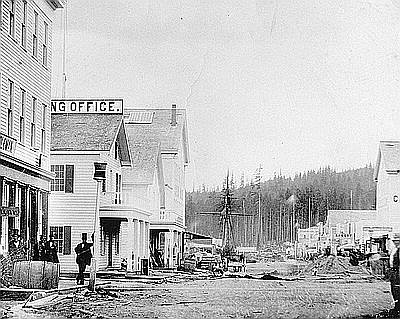 |
Oregon Historical Society photo
Portland's waterfront circa 1890. No ocean going ships, mostly tugs, scows and riverboats. Most ocean going ships were anchored off Astoria as the rivers were too shallow for deep-vessels. |
Sorry, but there were never "Shanghai Tunnels" in Portland.
There are tunnels in other west coast cities - San Francisco, Port Townsend and so - used to smuggle kidnapped men past friends, family and law enforcement to ships, but not in Portland.
Why?
During the era of rampant shanghaiing of men to serve as unwilling sailors, which in Portland was between 1879 when Jim Turk arrived, and 1917 when the La Follette Act was passed by the U.S. Congress, shanghaiing was rampant here. In fact, Portland was considered the most dangerous sea port in the world, so much so that ship's captain were paid bonuses by ship's owners to bring their ships to our fair city.
“. . . I will state that there is one port on the Pacific Coast
that has always been known as the greatest crimping
(shanghaiing) den in America. I refer to the port of Portland.”
- Andy Furuseth, President, International Seaman’s Union
Testimony before the U.S. Congress, 1911
The practice of Shanghaiing was also looked on with a blind eye by Portland officials and abetted by judges in the courts and some of the leading politicians of the day. In the 1890's, the heyday of the practice, Portland's police department even took an active part transporting prisoners from the city jail to ships in paddy-wagons where they were sold into slavery.
A bitter fact of the day is that county sheriffs and U.S. Marhalls actually escorted Shanghaiied men down river from Portland to waiting ships in Astoria. One Marshall, R.L. Stuart actually signed a contract to work for Larry Sullivan, the lead crimp of the 1890's. It can be seen in the Rare Books Room at the Multnomah County Library. So much for police protection.
There was reasons that law enforcement appeared to Shanghai men onto sailing ships: It was a Federal Law that once a man (or woman or child) signed ship's articles, he was indentured to the captain of the ship. i.e., he was owned by the captain, he was a slave, a condition upheld by the U.S. Supreme Court in 1897. To wit, the Thirteenth Amendment to the Constitution DID NOT apply to sailors. So, it was a federal crime to jump ship. Escorting a sailor to his ship was enforcing the law.
If the police and courts are taking part in the lucrative trade in human misery and large ships can't make it into Portland, why do you need to sneak men through tunnels? You don't, obviously.
 |
| Oregon Historical Society Photo.
Downtown Portland circa 1852. Note the
dirt streets that turned to mud during the
fall, summer, and spring rains.
|
Yes, some buildings that had basements did open the walls between neighboring buildings to move freight to and from the piers and wharves of the original Port of Portland that lay along the river as far south as today's Ross Island Bridge, but these were a practical solution to Portland's unusually narrow and then unpaved streets. Hauling cargo over mud streets fouled with horse, donkey and mule droppings was unpleasant at best, so moving freight through this ersatz underground made sense, even if they flooded most years. On top of this, Portland lacked any type of sewer system in the early years, so gutters full of human excrement flowed down to the river along all of the east-west streets.
Finally, both the Columbia and Willamette Rivers were simply too shallow for ocean going schooners and windjammers, so they stayed in Astoria and had the wheat "lightered" to them. Because of the mud flats off the piers of Astoria, larger ships anchored in the harbor and stayed there until they were fully loaded with grain taken from Portland to Astoria aboard stern and side wheeler river boats.
There were a few tunnels including early sewers, used by the residents of Portland Chinatown to get into and out of their ghetto along S.W. First between S.W. Jefferson and S.W. Oak without getting their traditional pigtails cut off by gangs of roving toughs.
By the 1880's, larger ships were able to make it to Portland due to the Army Corps of Engineers dredging the river, however they anchored downriver from downtown along the city of Albina were the wheat warehouses, silos and wharves were located - and are to this day. Any tunnels from the Old North End and downtown would have had to travel under the river. Does anyone really thing that would happen?
A simple answer to the question: Did Portland have Shanghai Tunnels? No, they weren't needed and were hardly possible.
Comments
Post a Comment